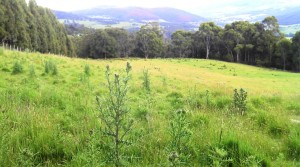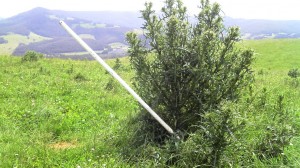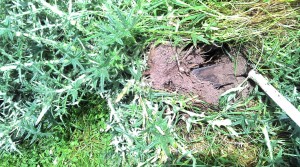We’ve come too far…
Jan 01
Sometimes it takes a bit of a jolt to realise you’re in a rut.
I’ve been freaking out at the number of Scotch thistles in our top paddocks. They’re often there, we usually make a couple of attacks on them each year, but we never really get a chance to get properly on top of them because there’s usually so much other stuff taking priority this time of year.

Scotch thistles. Prolific seeding, beautifully evolved for wind dispersal, hardy, and apparently good for warning of the approach of barefooted enemies.
This year, it looks like we won’t be harvesting a key crop, so that frees up a lot of time for an all out assault on the ‘scotchies’.
My first reaction to the sheer number of the plants was to think “tractor and sprayer”. But then I envisaged dragging the hose from the sprayer around the paddock, getting it tangled in the larger plants, and jumping on and off the tractor all day.
So then I thought it’d be an ideal situation for the ATV with the ‘saddle pack’. The four-wheeled bike is easier to manoeuvre, and with the small spray tank that is moulded to wrap around the seat, together with the hand wand that sprays out of a single nozzle courtesy of a dinky little 12 volt pump, it promised to make a very efficient approach to the problem.
But, as is often the case, it didn’t turn out to be quite so easy. Firstly I had to fit the saddle pack (the storage location of which I had to reacquaint myself with, not having used it for some years) to the bike. That meant removing the wooden box that we fitted ‘after-market’, and which is usually a permanent feature of the bike’s set-up; it’s incredibly handy for carrying stuff. Then I had to fit the saddle pack and wire up the pump. The electrical connections on the pump had been robbed for some other purpose, so I had to fit some new ones. With the unit finally ready to go, I headed over to the spray shed and mixed up the necessary brew, took the gauntlet gloves with me, and headed up the hill.
So, hours later, I finally managed to start the assault. It only lasted about half an hour, as it quickly became evident that the ATV wasn’t such a hot option. I only had a few metres of total reach from the seat, which meant several passes were required in larger patches of thistles, or that I had to dismount and unwind the full length of hose, which incurred the same tangling issue as the tractor. After 15 minutes or so, another problem re-introduced itself: it was quite difficult to tell which thistles had been sprayed and which hadn’t (and of course the industrial solution to this problem is to outlay even more money on spray products – a coloured dye to add to the mix). And there’s also the collateral damage to consider; regardless of how careful you are, you’re unlikely to manage to not unwittingly kill off some of the pasture you’re trying to preserve.
It hit me that I’d be better off going back to the way I used to deal with thistles as a kid on school holidays… hang a hoe over my shoulder and walk through the paddock chipping them out. No machine time required, no petrol, no spray, no chemical risk to pasture or user. And a thistle that’s been dispatched with by a hoe is easy to spot, so there’s no doubt whether the job had been done or not.
Once I started with the hoe, some more advantages became evident. I could hear the birds. I was walking under my own steam rather than being shaken up by a vehicle over uneven terrain. Indeed, I’ve now cleaned up slopes onto which I wouldn’t dream of taking a vehicle. I didn’t have to wear protective gear. And, perhaps even more critically, I could offer my children a chance to be involved in the job, rather than the job being just one more task on the farm that was too dangerous for youngsters – another task with a name which meant no more than precisely that to the next generation. And when family came to stay, they were able to help out as well; it was just a case of sharpening up some more tools and heading out into the paddock.

Taking a well-earned rest. We knocked off around 3500 thistles that day (we counted as far as 2100 and extrapolated!)
It’s interesting that my brain instantly jumped to the mechanised solutions. It’s not like I haven’t been an advocate for ‘old-time’ approaches in the past, but still, it seems the mind has been trained to regard a ‘big problem’ as necessitating a ‘big solution’, which somehow equates to industrialised approaches. There certainly are times when an industrialised approach is called for, but I think we’ve come too far in our reliance on such approaches. I think, on balance, we tend to ignore the baggage that such approaches incur, and forget the advantages conferred by doing things under our own steam.
Another recent example comes to mind. A friend who is studying theory of learning asked me to complete a maths problem and talk him through my thought processes. It was along the lines of “a group of kids went camping. Ten children ate half a bag of marshmallows. Then another 5 children ate two thirds of the remainder. Then another 5 kids ate half of what remained, leaving 9 marshmallows. How many were in the packet to begin with?”
As an IT worker I took an algebraic approach and basically wrote out the kind of formula I’d use to derive the answer programmatically. But the crazy thing was I wrote half as 0.5 and two thirds as 0.66. I ended up in knots trying to do long division with a decimal (which I couldn’t even remember how to do, not having done it since school years). Eventually, having uncomfortably endured my floundering, my friend gently nudged his calculator toward me, but I was still obsessed with trying to remember how to do it. It wasn’t until his wife came to see what was taking me so long, and his reply, “well, he’s doing it with decimals…”, that it hit me that I’d taken the most difficult approach I could possibly take. As soon as I wrote the formula using ½ and ⅓ the actual computation was a breeze.
The thing I couldn’t get over was that my friend had asked if my kids would like to try the sum, and quizzed me on whether they had done any sums with fractions at school – I indicated that they knew the basic concepts but probably hadn’t been exposed to manipulating fractions for computation. So I knew ahead of time what I was in for, and yet I still instantly converted the fraction to a decimal and, as a result of forgotten skills, had myself in knots. My only explanation for this is that I’m so used to using a calculator, that I would almost automatically key in 0.66666666 for a third, and so that was the approach I took on paper.
I wonder how many other things we do in a day, taking the long way around, because we’re so used to doing things an “easier” way.


